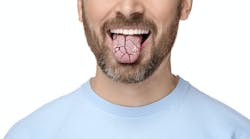The next generation of toothpaste for xerostomia patients
What do you first think of when your mirror sticks to your patient’s buccal mucosa? Or when they present with frothy, thick, or ropey saliva? Or perhaps they present with dry, cracked lips, or a glossy, red, or fissured tongue? And let’s not forget the telltale sign: a medical chart listing one or more medications with xerostomia as a side effect.
These are clear indicators of decreased saliva flow, and whether the patient is experiencing the painful symptoms of xerostomia or not, we know they have a much higher risk of developing dental caries. This is because the lack of saliva means a lack of the key minerals calcium and phosphate, which are crucial for enamel remineralization.
For decades, the standard recommendation for xerostomia patients has been fluoridated toothpaste containing 5,000 parts per million (ppm) sodium fluoride. These products require a prescription because their fluoride concentration exceeds what the Food and Drug Administration (FDA) deems safe for over the counter (OTC) use.
However, these prescriptions come with significant drawbacks. According to FDA guidelines, these toothpastes should be used only once daily. Also, pediatric patients aged 6-16 must spit and rinse thoroughly immediately after brushing with the toothpaste to prevent overexposure.
A new solution for xerostomia patients
What if there were a toothpaste that could be used safely twice a day while delivering equal or even greater remineralization benefits?
While fluoride remains a valuable tool in caries prevention, its effectiveness is severely limited for xerostomia patients due to their lack of saliva. It’s not fluoride, but rather fluorapatite—a compound formed from fluoride, calcium, and phosphate—that protects enamel from demineralization. The chemistry is one unit of fluorapatite (Ca10(PO4)6F2), which requires two fluoride ions, 10 calcium ions, and six phosphate ions.1 For xerostomia patients, a toothpaste that supplements fluoride with calcium and phosphate is essential to create fluorapatite effectively.2
Enter nano-hydroxyapatite (nHAp), one of the most biocompatible ingredients ever developed. This material comprises 97% of our enamel—calcium, phosphate, oxygen, and hydrogen—and shares the same six-sided hexagonal crystal structure as natural enamel hydroxyapatite. Its biomimetic nature allows enamel to recognize it and use it for remineralization, like the hydroxyapatite the body makes. In fact, nHAp alone has been shown to match or even surpass the effectiveness of OTC fluoride in remineralization.3
For nHAp to work optimally, there are two critical factors: concentration and size. A review of 28 studies concluded that the "optimal concentration of nHAp in dentifrices is 10%.”4 This makes sense, as nHAp works primarily through biophysical interactions; its crystals physically fill decalcified areas and exposed dentinal tubules, addressing both caries and hypersensitivity. Think of patching a small hole with spackling paste: without enough material, the hole remains partially unfilled.
Size also matters. Natural enamel hydroxyapatite measures 20-50 nanometers (nm), so to maintain the benefits of biomimicry, synthetic nHAp should fall within this range. Larger particles, such as “micro” hydroxyapatite, compromise efficacy.5
Unfortunately, many brands in the US have yet to align with this science. Because nHAp is costly and not yet approved by the FDA as an anticaries agent, most manufacturers opt for lower concentrations and/or larger particles. Fortunately, more brands are disclosing that they use the optimal 10% concentration of nano-sized (20-50 nm) nHAp.
There’s more …
Now for the real game changer: combining nHAp with fluoride. A 2017 study showed a “synergistic effect” when optimal levels of nHAp were added to fluoride toothpaste.6 The mouth becomes supersaturated with calcium and phosphate, allowing for abundant fluorapatite formation. This combination offers enhanced protection without the daily use restrictions of prescription-strength toothpaste.
In December 2023, Therametric Technologies conducted a remineralization pilot study in a simulated xerostomia environment. A toothpaste containing 10% nHAp, 0.22% sodium fluoride, and 14% xylitol was tested against a leading 5,000 ppm fluoride toothpaste. The toothpaste combining nHAp (and xylitol) with the fluoride demonstrated six times greater remineralization levels according to the Vickers Hardness Number (VHN).7
This superior performance is attributed to the nHAp’s ability to supply the necessary calcium and phosphate for fluorapatite formation. Its level of fluoride makes it safe for twice-daily use. To maximize its benefits, patients should spit but refrain from rinsing for at least 30 minutes after brushing.
The next time a patient presents with xerostomia symptoms, reconsider the traditional fluoride-only recommendation. Instead, suggest a toothpaste that harnesses the synergy of 10% nHAp with OTC fluoride. Your patients may experience significantly improved cavity protection.
References
- Vanichvatana S, Auychai P. Efficacy of two calcium phosphate pastes on the remineralization of artificial caries: A randomized controlled double-blind in situ study. Int J Oral Sci. 2013;5(4):224-228. doi:10.1038/ijos.2013.67
- Meyer F, Amaechi BT, Fabritius HO, Enax J. Overview of calcium phosphates used in biomimetic oral care. Open Dent J. 2018;12:406-423. doi:10.2174/1874210601812010406
- Manchery N, John J, Nagappan N, Subbiah GK, Premnath P. Remineralization potential of dentifrice containing nanohydroxyapatite on artificial carious lesions of enamel: a comparative in vitro study. Dent Res J. 2019;16(5):310-317.
- Anil A, Ibraheem WI, Meshni AA, Preethanath RS, Anil S. Nano-hydroxyapatite (nHAp) in the remineralization of early dental caries: a scoping review. Int J Environ Res Publ Health. 2022;19(9):5629. doi:10.3390/ijerph19095629
- Chen L, Al-Bayatee S, Khurshid Z, Shavandi A, Brunton P, Ratnayake J. Hydroxyapatite in oral care products–a review. Materials (Basel, Switzerland). 2021;14(17):4865. doi:10.3390/ma14174865
- Ebadifar A, Nomani M, Fatemi, SA. Effect of nano-hydroxyapatite toothpaste on microhardness of artificial carious lesions created on extracted teeth. J Dent Res, Dent Clin, Dent Prospects. 2017;11(1), 14-17. https://doi.org/10.15171/joddd.2017.003
- McClure HC. In vitro enamel remineralization via a pH cycling model: pilot study (study No. 23-559). Therametric Technologies. December 7, 2023.
About the Author
Adam Van Sickle, RDH, MILS
Adam Van Sickle, RDH, MILS, practices in Durango, Colorado, and is an accomplished educator/researcher affiliated with Dr. Jen Oral Care. Adam has presented lectures to hundreds of dental offices and at dental conferences. Prior to his career in dental hygiene, Adam served as a research librarian with a master's in information and library science, honing his skills in information retrieval and analysis. Today, he channels his passion for evidence-based dentistry into advancing dental science.


